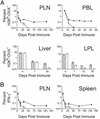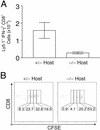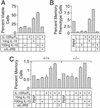IL-15R alpha expression on CD8+ T cells is dispensable for T cell memory - PubMed (original) (raw)
IL-15R alpha expression on CD8+ T cells is dispensable for T cell memory
Patrick R Burkett et al. Proc Natl Acad Sci U S A. 2003.
Abstract
The generation and maintenance of immunological memory requires the activation, expansion, and persistent proliferation of antigen-specific T cells. Recent work suggests that IL-15 may be important for this process. Surprisingly, we now find that expression of the high-affinity receptor for IL-15, IL-15R alpha, on T cells is dispensable for the generation or maintenance of memory CD8(+) T cells. By contrast, IL-15R alpha expression on cells other than T cells is absolutely critical for this function. These findings may be related to IL-15R alpha's ability to present IL-15 in trans to low-affinity IL-15R beta gamma(c) receptors on memory CD8(+) T cells. These unexpected results provide insights into how IL-15R alpha supports memory CD8(+) T cells.
Figures
Figure 1
IL-15Rα expression on CD8+ T cells is dispensable for CD8+ T cell memory. Similar percentages of IL-15Rα+/− (■) and IL-15Rα−/− (□) OT-1+ RAG−/− CD8+ T cells at memory time points in the PBL. Data represent the mean of four mice per time point ± SEM.
Figure 2
Naïve IL-15Rα-competent CD8+ T cells show normal short-term maintenance and initial expansion in response to either OVA or OVA plus poly(I⋅C) in both IL-15Rα+/− and IL-15Rα−/− mice. There were similar percentages of H2Kb-OVA+ CD8+ cells in the peripheral lymph nodes (PLNs) 4 days after immunization in both IL-15Rα+/− and IL-15Rα−/− mice. Plots are representative of at least two mice per condition. Data represent mean ± SEM.
Figure 3
IL-15Rα−/− mice fail to support IL-15Rα-competent memory CD8+ T cells, despite normal initial responses. (A) Percentages of H2Kb-OVA+ in the PLN, PBL, liver, and lamina propria lymphocytes (LPLs) of IL-15Rα+/− (filled squares or bars) or IL-15Rα−/− mice (open squares or bars) at various time points following immunization with OVA and poly(I⋅C). (B) Percentages of IFN-γ+ CD8+ T cells are shown in the PLN and spleen of IL-15Rα+/− (filled squares) or IL-15Rα−/− mice (open squares) at various time points after immunization with OVA and poly(I⋅C). Data represent mean ± SEM and all data points are reflective of at least two mice, with most reflecting three or more mice.
Figure 4
IL-15Rα−/− mice fail to properly maintain IL-15Ra+/− memory CD8+ T cells. (A) Reduced numbers of IFN-γ+ IL-15Rα+/− memory CD8+ T cells are recovered from IL-15Rα−/− mice 110 days after secondary transfer. The mean total number of Ly5.1+ IFN-γ+ cells recovered from both spleen and lymph nodes are shown ± SEM. Data represent three mice. (B) IL-15Rα+/− memory CD8+ T cells undergo reduced proliferation 55 days after secondary transfer into IL-15Rα−/− hosts. FACS plots are representative of at least two mice. Plots are gated on Ly5.1+ CD8+ T cells and the percentage in each generation is indicated.
Figure 5
IL-15Rα expression on both radiation-sensitive and radiation-resistant cells maintains memory CD8+ T cells. IL-15Rα+/+ (filled squares or triangles) or IL-15Rα−/− (open squares or triangles) mice were lethally irradiated and reconstituted with either IL-15Rα+/− (squares) or IL-15Rα−/− (triangles) bone marrow. At least 4 months after irradiation, mice received OT-1+ RAG−/− CD8+ T cells, and were immunized with OVA and poly(I⋅C). Data represent mean ± SEM of PBLs from at least two mice per group, with most reflecting three or more mice.
Figure 6
Trans presentation of IL-15 by IL-15Rα can support memory CD8+ T cell survival in vitro. (A) IL-15 presented in trans by IL-15Rα supports T cell viability in vitro. The number of viable cells after 4 days is reported as a percentage of total collected events. (B) IL-15 presented in trans by IL-15Rα selectively supports memory phenotype CD8+ T cells. The percentage of total viable cells that are CD44Hi CD8+ T cells after 4 days of culture is indicated. (C) IL-15Rα-bound IL-15 comparably supports both IL-15Rα+/− and IL-15Rα−/− memory OT-1+ RAG−/− CD8+ T cells in vitro. T cells were purified from WT mice that had received either IL-15Rα+/− or IL-15Rα−/− OT-1+ RAG−/− CD8+ T cells and been immunized with poly(I⋅C) and OVA 40 days before isolation. The percentage of total viable cells that are memory OT-1+ CD8+ T cells after 4 days in culture is indicated. The bars labeled Input reflect the percentage of such cells before culture. This experiment was performed three times with similar results.
Similar articles
- Distinct cell types control lymphoid subset development by means of IL-15 and IL-15 receptor alpha expression.
Schluns KS, Nowak EC, Cabrera-Hernandez A, Puddington L, Lefrançois L, Aguila HL. Schluns KS, et al. Proc Natl Acad Sci U S A. 2004 Apr 13;101(15):5616-21. doi: 10.1073/pnas.0307442101. Epub 2004 Apr 1. Proc Natl Acad Sci U S A. 2004. PMID: 15060278 Free PMC article. - T cell-independent interleukin 15Ralpha signals are required for bystander proliferation.
Lodolce JP, Burkett PR, Boone DL, Chien M, Ma A. Lodolce JP, et al. J Exp Med. 2001 Oct 15;194(8):1187-94. doi: 10.1084/jem.194.8.1187. J Exp Med. 2001. PMID: 11602647 Free PMC article. - LFA-1 defect-induced effector/memory CD8+ T cell apoptosis is mediated via Bcl-2/Caspase pathways and associated with downregulation of CD27 and IL-15R.
Ye Z, Shi M, Xu S, Xiang J. Ye Z, et al. Mol Immunol. 2010 Aug;47(14):2411-21. doi: 10.1016/j.molimm.2010.02.005. Epub 2010 May 31. Mol Immunol. 2010. PMID: 20569988 - The roles of interleukin-15 receptor alpha: trans-presentation, receptor component, or both?
Schluns KS, Stoklasek T, Lefrançois L. Schluns KS, et al. Int J Biochem Cell Biol. 2005 Aug;37(8):1567-71. doi: 10.1016/j.biocel.2005.02.017. Epub 2005 Mar 5. Int J Biochem Cell Biol. 2005. PMID: 15896666 Review. - Multiple effects of immunostimulatory DNA on T cells and the role of type I interferons.
Sun S, Zhang X, Tough D, Sprent J. Sun S, et al. Springer Semin Immunopathol. 2000;22(1-2):77-84. doi: 10.1007/s002810000028. Springer Semin Immunopathol. 2000. PMID: 10944802 Review.
Cited by
- Essential roles of DC-derived IL-15 as a mediator of inflammatory responses in vivo.
Ohteki T, Tada H, Ishida K, Sato T, Maki C, Yamada T, Hamuro J, Koyasu S. Ohteki T, et al. J Exp Med. 2006 Oct 2;203(10):2329-38. doi: 10.1084/jem.20061297. Epub 2006 Sep 11. J Exp Med. 2006. PMID: 16966429 Free PMC article. - Cutting edge: IL-15-independent NK cell response to mouse cytomegalovirus infection.
Sun JC, Ma A, Lanier LL. Sun JC, et al. J Immunol. 2009 Sep 1;183(5):2911-4. doi: 10.4049/jimmunol.0901872. Epub 2009 Jul 31. J Immunol. 2009. PMID: 19648279 Free PMC article. - Trans-presentation of IL-15 by intestinal epithelial cells drives development of CD8alphaalpha IELs.
Ma LJ, Acero LF, Zal T, Schluns KS. Ma LJ, et al. J Immunol. 2009 Jul 15;183(2):1044-54. doi: 10.4049/jimmunol.0900420. Epub 2009 Jun 24. J Immunol. 2009. PMID: 19553528 Free PMC article. - Distinct cell types control lymphoid subset development by means of IL-15 and IL-15 receptor alpha expression.
Schluns KS, Nowak EC, Cabrera-Hernandez A, Puddington L, Lefrançois L, Aguila HL. Schluns KS, et al. Proc Natl Acad Sci U S A. 2004 Apr 13;101(15):5616-21. doi: 10.1073/pnas.0307442101. Epub 2004 Apr 1. Proc Natl Acad Sci U S A. 2004. PMID: 15060278 Free PMC article. - IL-15 functions as a danger signal to regulate tissue-resident T cells and tissue destruction.
Jabri B, Abadie V. Jabri B, et al. Nat Rev Immunol. 2015 Dec;15(12):771-83. doi: 10.1038/nri3919. Epub 2015 Nov 16. Nat Rev Immunol. 2015. PMID: 26567920 Free PMC article. Review.
References
- Murali-Krishna K, Lau L L, Sambhara S, Lemonnier F, Altman J, Ahmed R. Science. 1999;286:1377–1381. - PubMed
- Grabstein K H, Eisenman J, Shanebeck K, Rauch C, Srinivasan S, Fung V, Beers C, Richardson J, Schoenborn M A, Ahdieh M, et al. Science. 1994;264:965–968. - PubMed
Publication types
MeSH terms
Substances
Grants and funding
- AI07090/AI/NIAID NIH HHS/United States
- P30 DK042086/DK/NIDDK NIH HHS/United States
- AI45860/AI/NIAID NIH HHS/United States
- GM07281/GM/NIGMS NIH HHS/United States
- R01 AI045860/AI/NIAID NIH HHS/United States
- T32 GM007281/GM/NIGMS NIH HHS/United States
- DK42086/DK/NIDDK NIH HHS/United States
- T32 AI007090/AI/NIAID NIH HHS/United States
LinkOut - more resources
Full Text Sources
Other Literature Sources
Molecular Biology Databases
Research Materials





